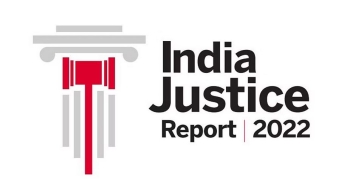
.jpg) Lancy Lobo
Lancy Lobo

On April 4, 2023, “India Justice Report” (IJR) was released based on data of States and Union Territories of India. It was based on four pillars of justice delivery mechanisms, viz., Police, judiciary, Prisons and Legal Aid. The States were classified as large states, middle-sized states and small states. The data was all from government sources. It carried a comparison of years 2019, 2021 and 2022. Each of the four pillars were analyzed through the prism of budgets, human resource, workload, diversity, infrastructure, and trends (or intentions to improve). All in all, 102 indicators across four pillars have been used to measure the deterioration or improvement over the years. Each State is ranked on each of these pillars as also a composite picture. Hence one gets an idea of which state is holding which rank therein.
The IJR is the outcome of continuous and sustained cooperation between the members of the Collective and the founding team of Tata Trusts. The Collective consisted of Centre for Social Justice, Common Cause, Commonwealth Human Rights Initiative, DAKSH, TISS-Prayas, Vidhi Centre for Legal Policy, and How India Lives. Acknowledgement from Project Leader, Valay Singh, Introduction by the Editor and Convenor, Maja Daruwala and a Foreword from Uday Umesh Lalit, the former Justice of the Supreme Court, have appropriately contextualized this report. Indeed it is a great effort to highlight the changing character of democracy in India through hard facts. Some significant findings are:
Police:
1. Every State has statutorily mandated quotas for SC, ST, OBCs for Police. However, only Karnataka has been able to fulfil these reservations.
2. Not a single State/UT meets their own reserved quotas for women in police.
3. In 19 States/UTs, urban police stations serve greater populations than their rural counterparts. Kerala’s urban police stations serve ten times the population of a rural one and Gujarat’s four times.
4. State Human Rights Commissions have a total of 33,312 pending cases across all 25 State Human Rights Commissions in March 2021. National average vacancy across 25 SHRCs is 44 per cent.
5. Compliance with Supreme Court judgment on installation of CCTVs in all 14 spots (as directed by the apex court) is found only in Arunachal Pradesh. Only 8 States/UTs reported having night-vision equipped CCTVs.
Judiciary:
1. No court works with a full complement of judges except the High Court of Sikkim and the district courts in Chandigarh.
2. At the district court level, no State/UT could fully meet all its Scheduled Castes, Scheduled Tribes and Other Backward Classes’ quotas. Data on SC/ST/OBC judges is not available for High Courts.
3. Among the 18 large and mid-sized states, only Kerala could achieve case clearance rates of 100 per cent and more at both High Court and subordinate court levels.
Legal Aid:
1. The reduction in the number of legal services clinics have dropped to 4,742 in 2022 from 14,159 in 2020 which means a reduction of 9,147.
2. The total value of settlement by National Lok Adalats during 2021-2022 was Rs. 7,322 crore.
Prisons:
1. 32 States/UTs where the share of undertrials is more than 60 per cent.
2. 24 States/UTs that provided education to less than 59 per cent inmates during 2021.
3. Five States didn’t provide any vocational training to inmates in 2021.
Maja Daruwala in her introduction draws further attention to some key issues in various States such as budgets allotted and their use, human resources, diversity, infrastructure and so on. Regarding funds she writes, “If funds are tight, what is available is frequently left underutilized”. With reference to human resources in justice system, she said, “Vacancies continue to plague all areas of the justice system and can touch 83 per cent as among the prison staff in Ladakh. Between 2020 and 2021 the actual number of prison doctors dropped drastically, taking vacancies to nearly 50 per cent or one doctor for 842 inmates, instead of one for 300 inmates’ benchmark”.
Regarding diversity in personnel representing caste and gender, “Despite decades of heated debate, while individual states may meet one or other category, no state meets all three quotas across all subsystems. Nor are women anywhere near parity”. Concerning infrastructure, she observes that “Prison infrastructure remains wholly inadequate. Of the 1,314 prisons 391 are overcrowded by more than 50 per cent”. Other facilities are rudimentary.
Given the commitment to international Sustainable Developmental Goals, India is committed to “promoting peaceful and inclusive societies, providing access to justice for all and building effective, accountable and inclusive institutions at all levels. However, this timely report shows a mirror to the status of justice delivery mechanisms which leaves much to be desired.
This report also carries an important data comparing India with the rest of the countries in the world on a number of themes such as the Rule of Law index, Global peace index, Human development Index, Global gender gap index, Democracy index, Sustainable Development global report index, World Press freedom index and SDG Gender index for the year 2022.
Overall there has been a downward slide in most of these indices for India. It is alarming that increasingly illiberal ideologies are taking hold of India, giving poor governance despite the rhetoric of politicians, who use money, muscle, media, and machines to come to power. It also shows how the democratic institutions have become weaker. This is a cause of great concern.